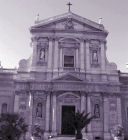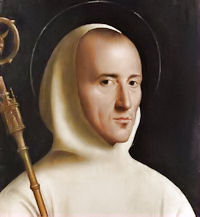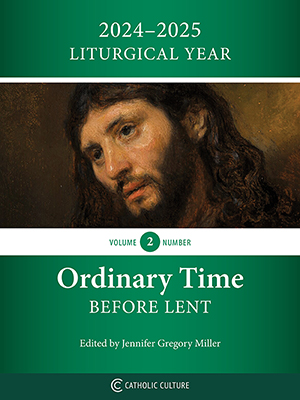Lent: April 1st
Saturday of the Fourth Week of Lent
Other Commemorations: St. Hugh of Grenoble, Bishop (RM)
» Enjoy our Liturgical Seasons series of e-books!
"Everyone who exalts himself will be humbled, and the one who humbles himself will be exalted." (Lk. 18:14) "Even if we should have mounted to the very pinnacle of virtue, let us consider ourselves last of all; having learned that pride is able to cast down even from the heavens themselves him who takes not heed, and humbleness of mind to bear up on high from the very abyss of sins him who knows how to be sober. For this it was that placed the publican before the Pharisee." — St. John Chrysostom
| The Station is in the church of St. Susanna, virgin and martyr of Rome. The first Christian place of worship was built here in the 4th century. It was probably the titulus of Pope Caius (283-296). Caius was St. Susanna's uncle, and tradition claims that the church stands on the site of her martyrdom. |  |
Meditation- Mary's Acceptance of All, for Love of Us
Mary, there present as eyewitness to the sacred Passion of her divine Son on Good Friday, was destined to be present in spirit and maternal interest at future scenes in the unending tragedy of Christ Jesus' Passion in His members through all the Christian centuries. She was destined to be present precisely in that high office to which Jesus Himself would assign her at the foot of His cross on Calvary, as the Mother of all who live the divine life of the children of the Second Adam. Hence, to fit her for this office of Mediatrix who would have Christ-like compassion on all our human infirmities, she too must be tempted in all things as we are (without sin), that we might with confidence go to the throne of her mercy, there to obtain the precious grace of Christ-like obedience through her who herself learned perfect obedience by the things which she suffered with her divine Son. She also must be tested that, by her union with the very humiliation and suffering with which the Son purchased His title of High Priest, the Mother too might at the same time purchase her title — Mediatrix of all the graces to be dispensed from the treasury of the Sacred Heart of Him, who alone is in His own right the great High Priest, the universal and plenipotentiary Mediator of the New Testament.
Mark well, therefore—it was on Good Friday, during these hours of darkness and shame and anguish which Mary shared with Jesus most intimately, that the Savior fountains of the Second Adam poured their tenderest mercifulness into the heart of the Second Eve so copiously, that until the Book of Life is filled the whole world might with unlimited filial confidence have recourse to Mary—
The Health of the sick,— Our Way to the Father by Rev. Leo M. Krenz, S.J.
The safe Refuge of sinners,
The sympathetic Comforter of the afflicted,
The unfailing Help of Christians
Things to Do:
St. Hugh of Grenoble (or Châteauneuf)
In the eleventh century the diocese of Grenoble in southeastern France was notorious for corruption. Simony (the buying and selling of spiritual goods), usury, immorality, and ignorance were rampant in that area. During a Church synod at Avignon in 1080, it was decided that a strict bishop should be appointed to correct these abuses; one who could lead both clergy and laity to conform to the laws of the Church. Saint Hugh was unanimously elected to the office.
Hugh was born near Valence in southern France in 1053. After completing his formal education, he accepted a canonry (an official membership in the bishop's council) in the cathedral of that city. In his early twenties, he met the bishop of Die, who was impressed by Hugh's virtue and administrative talents and offered him a position in his own diocese. Hugh accepted the offer and later went with the bishop to the synod at Avignon, where he was unexpectedly elected to the see of Grenoble. After being ordained at the age of twenty-seven, he was consecrated bishop by the pope.
For two years, Hugh preached, fasted, and prayed in an effort to correct the many abuses in his diocese. Then, feeling that a new bishop might be more successful, he resigned and entered the novitiate at the Benedictine abbey of Chaise-Dieu. He was there only a short time when Pope Gregory VII commanded him to return to his see. Once again in Grenoble, Hugh more effectively fought the evils in his diocese. The poor were his greatest concern; once, during a time of famine, he sold his ornate gold chalice to buy them food. In 1084, when Saint Bruno, founder of the Carthusian Order, was looking for a site for a new monastery, Hugh, guided by a dream, granted him the territory known as "the Chartreuse" which gave the order its name. Hugh is often portrayed in art in connection with the Carthusians; he admired the monks and frequently visited them, happily joining in their exercises and performing the most menial tasks.
Throughout his fifty-two years as bishop of Grenoble, Hugh harbored a desire for contemplative life, but because of the tremendous influence of his holiness, pope after pope refused to release him from office. He died after a long illness and was canonized two years later by Pope Innocent II.
—The Lives of the Saints for every day of the year, Vol. 1: January-April
Patronage: against headaches; Grenoble, France
Symbols and Representation: carrying a lantern; one of a group of seven stars, representing the founders of the Carthusians; with Saint Bruno; with three flowers in his hand
Highlights and Things to Do:
- Read more about St. Hugh:
- In 1084 St. Hugh gave to St. Bruno and his six companions the land of La Grande, a desert in his diocese, called the Chartreuse, where they could live in solitude. It was here that St. Bruno founded the Carthusians. The entire name of the Carthusians is "Order of the Chartreuse." The liqueur Chartreuse originates from the Carthusians. Find out the history.
- Find out more about Carthusian monks and see the list of monasteries in the world.






